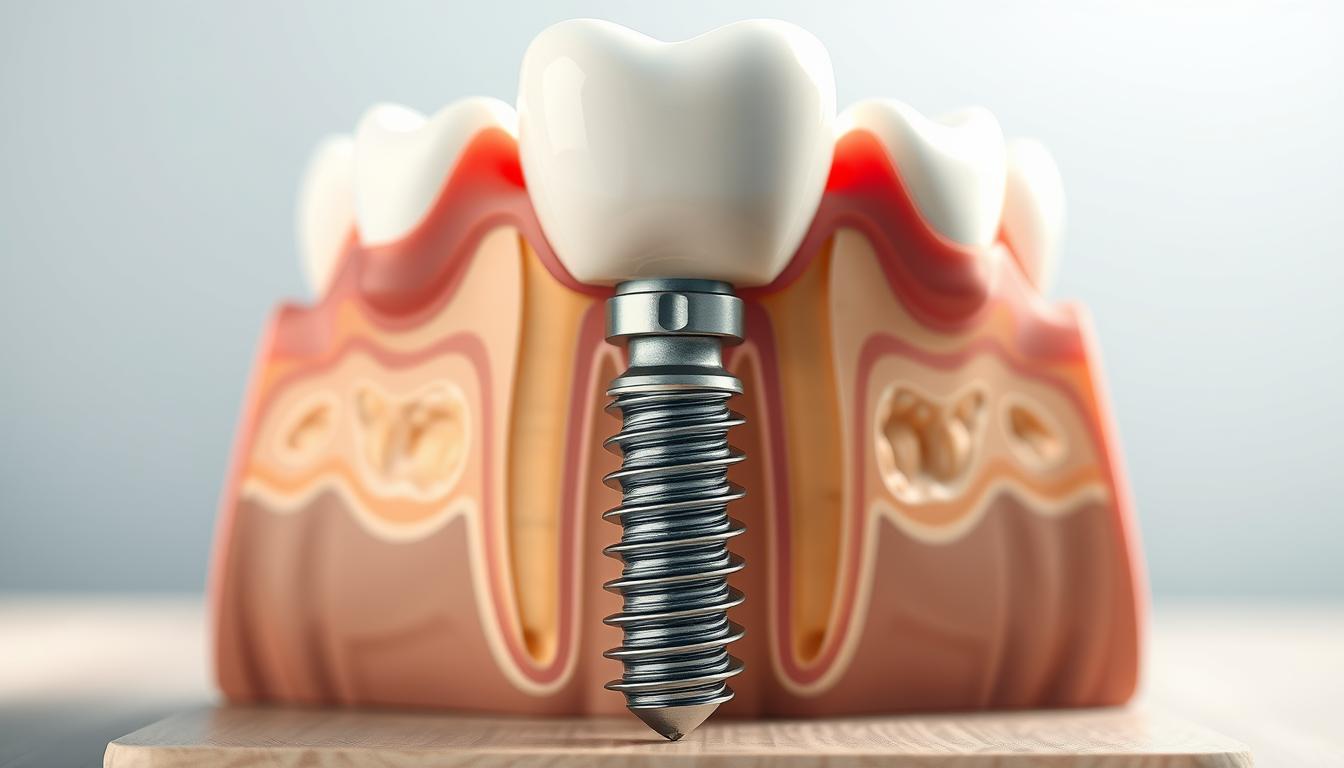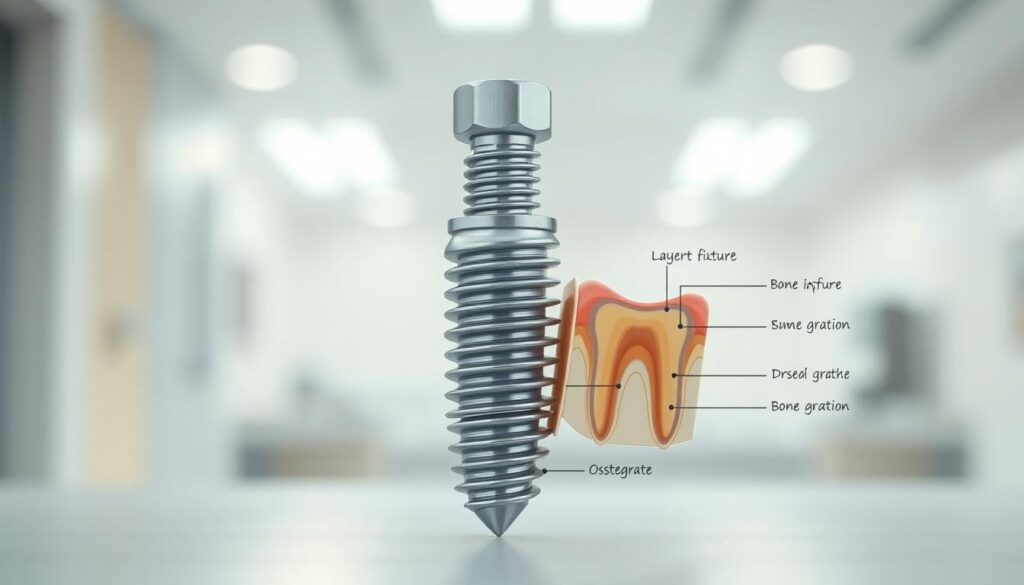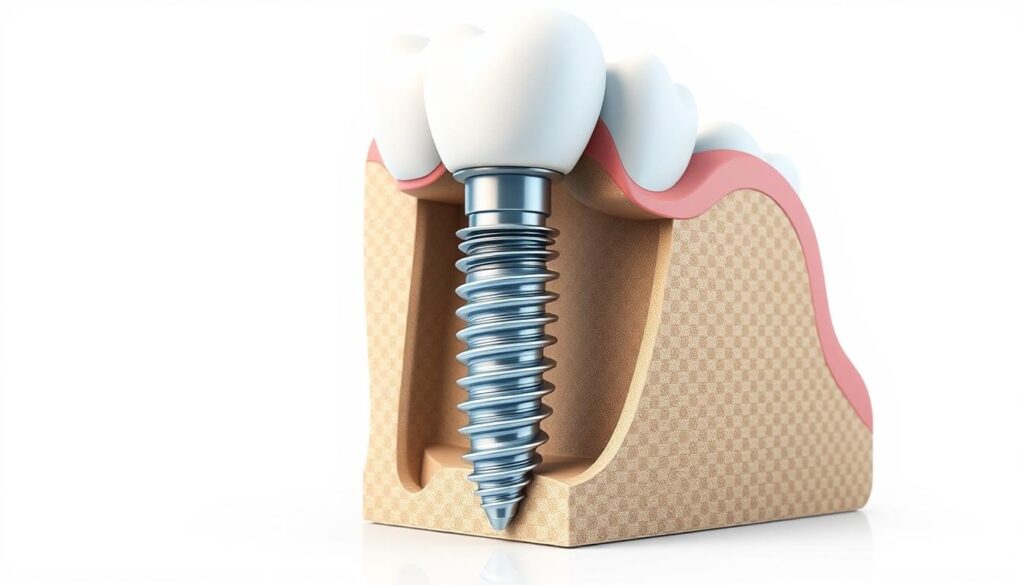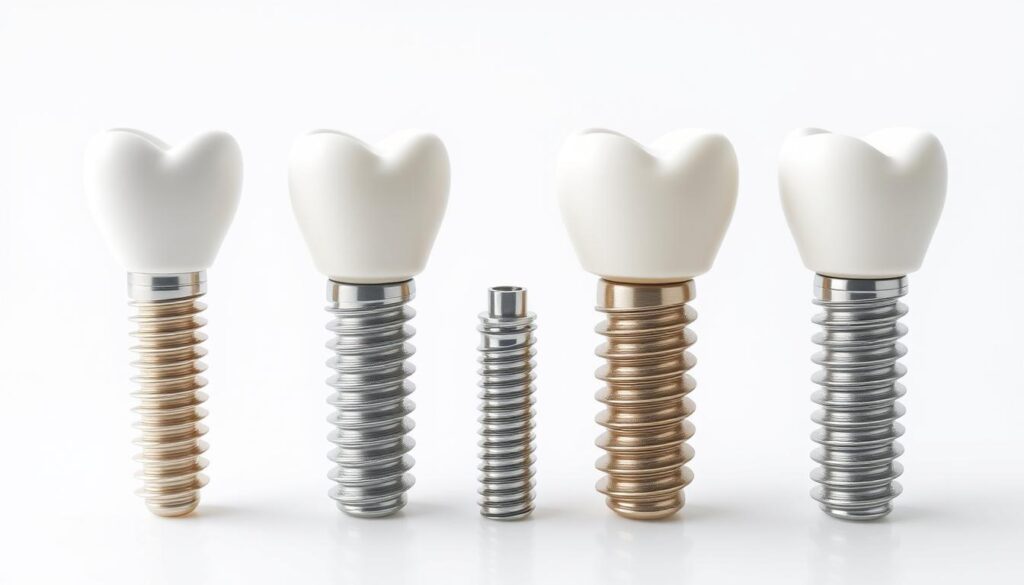What is a Dental Implant, and How Does It Replace a Tooth?

Did you know that nearly 178 million people in the United States are missing at least one tooth? This shows the need for a reliable way to fix chewing and smile issues. So, what is a dental implant?
A dental implant is a small post, often made of titanium, placed in the jawbone. It acts as an artificial tooth root. This setup keeps your bite strong and looks natural.
After the implant fuses with the bone, a crown is attached. This crown looks like a real tooth and helps keep your mouth healthy.
Key Takeaways
- A dental implant can function much like a real tooth.
- Titanium posts integrate with the jawbone for lasting support.
- Bone preservation is a central benefit of this treatment.
- An implant helps restore normal chewing power and aesthetics.
- Proper placement and care can lead to long-term success.
Understanding Dental Implants: A Basic Overview
Dental implants combine skill with the latest technology. They offer a strong option for those missing teeth. A well-planned dental implant procedure could be the answer.
Definition of a Dental Implant
A dental implant is a titanium anchor in the jaw for a custom crown. It fills gaps where teeth are missing, helping patients chew as they should.
Types of Dental Implants
Doctors usually pick between endosteal and subperiosteal implants. Endosteal implants go straight into the bone. Subperiosteal ones sit above the jawbone, for those with less bone.
| Type | Placement | Ideal For |
|---|---|---|
| Endosteal | Within the jawbone | Patients with sufficient bone |
| Subperiosteal | Under gum tissue but above bone | Individuals with limited bone volume |
Benefits of Dental Implants
People choose implants for their stability and bone-saving potential. The benefits include:
- Enhanced chewing efficiency
- Preserved jaw structure
- Improved confidence and speech
The Structure of a Dental Implant
Many people look for tooth replacements that last and look like real teeth. That’s why experts focus on advanced designs. These designs are among the best options today. They have hidden and visible parts that work together to create a strong base in the jaw.

Components of a Dental Implant
Each implant has different parts that work together as a system. Experts often talk about:
- Fixture: The post placed in the jawbone
- Abutment: The connector attaching the post to the final restoration
- Crown or Denture: The part that looks like a real tooth
Materials Used in Dental Implants
Experts use strong metals and ceramics for implants. Titanium is a top choice because it’s safe and works well. The FDA has approved it for implants. Some doctors prefer zirconium for its strength and natural look.
The Dental Implant Procedure Explained
Getting an implant is a process with several steps. These steps ensure a tooth replacement that looks and feels natural. They focus on comfort, jawbone health, and stability.
Initial Consultation and Planning
First, doctors check your oral health with exams and scans. They plan your treatment to make sure there’s enough bone for the implant. They might suggest tooth replacement if your tooth can’t be fixed.
Surgical Placement of the Implant
The surgeon makes a small cut in your gum. They place an implant post in your jawbone. This helps keep your bone and supports chewing.
Osseointegration Process
Next, your body fuses the implant with bone cells. This step is crucial for a strong base for your crown. It ensures your implant lasts long and supports your bite.
- Custom evaluation for each patient
- Careful placement to avoid nerve structures
- Guided healing for bone fusion
| Stage | Estimated Duration | Key Outcome |
|---|---|---|
| Consultation | 1–2 visits | Planning and assessments |
| Implant Placement | 1 appointment | Placement of titanium post |
| Osseointegration | 3–6 months | Fusion of implant and bone |
| Final Restoration | 1 appointment | Attachment of crown or bridge |
Preparing for Dental Implant Surgery
Before surgery, it’s smart to check your overall health and talk about what you want. You might think about whether to get a dental implant or a bridge. Both options can affect your teeth and how you look. This step is key to getting good results.
Pre-Surgery Considerations
Doctors look at your medical history and check your mouth for any hidden problems. Blood tests help make sure you can heal well. This careful planning helps make sure the implant goes in right.
Necessary X-Rays and Scans
Imaging shows how strong your bones are and what your jaw looks like. X-rays or 3D scans help find any problems and plan the implant’s angle. This helps avoid surprises during surgery and makes the implant stable for a long time.
Medications and Anesthesia Options
Doctors might suggest antibiotics to help you heal. Local anesthesia makes you feel less pain, and deeper sedation is for more complicated cases. Thinking about dental implants or bridges also means considering the anesthesia that makes you comfortable.
Aftercare Following Dental Implant Surgery
Many patients wonder how to keep their implants comfortable for a long time. A mix of medicines, cold compresses, and rest helps from the start. Regular dental visits also offer peace of mind, backed by the American Dental Association and global research.
Immediate Post-Operative Care
Some people might see a bit of swelling or bleeding. But these issues usually go away with the right care. Taking it easy helps your body heal smoothly.
- Apply gentle pressure with gauze if light bleeding occurs.
- Use ice packs for brief intervals to reduce puffiness.
- Follow pain management plans set by your dentist.
Long-Term Maintenance of Dental Implants
Keeping up with care is key to the success of your implants. Brushing and flossing right can prevent plaque around the implant. This care is crucial for anyone wanting the best oral health.
- Brush twice daily with a soft-bristled toothbrush.
- Consider using interdental brushes or a Waterpik for enhanced cleaning.
- Visit the dental office for routine exams and professional cleanings.
Potential Risks and Complications
Patients often worry about unexpected problems during implant placement. Studies show it’s key to know about possible issues. This knowledge helps plan and keep treatment on track.
Common Dental Implant Complications
Complications can include loose implants if bone doesn’t fully fuse. Nerve damage near the implant site is also a risk. Sinus problems can happen in the upper jaw.
Infection might occur if hygiene is poor or healing tissues fail. Serious issues can extend treatment time, affecting cost.
How to Minimize Risks
Using 3D imaging helps avoid problems. Quitting smoking and good oral care are crucial, as the Mayo Clinic advises. Regular check-ups are vital to keep implants healthy and prevent future issues.
This approach lowers risks and ensures a lasting outcome. It’s a key part of successful dental implant treatment.
Cost of Dental Implants
Many patients ask why dental implants cost so much. A skilled dental implant surgeon uses top-quality materials and advanced technology. This ensures the implants work well for a long time. Even though it’s expensive, the benefits are worth it.

Factors Influencing Dental Implant Costs
Several things affect the price. For example:
- Bone grafts or sinus lifts
- Advanced brands of implants
- Specialized tools for guided surgery
- Additional consultations and follow-up visits
Insurance Coverage for Dental Implants
Insurance can help, but it’s not always enough. It’s important to check your policy. Talk to your dentist about payment plans. This way, you can get the care you need without breaking the bank.
Finding the Right Dentist for Implants
Finding a dentist with the right skills is important. They should be good at talking to patients and know the latest techniques. Checking their credentials and reading what others say can show if they care about their work.
Oral surgeons, periodontists, or prosthodontists might work together for your treatment. Choosing experts who focus on regular check-ups and care for implants can help keep them healthy for a long time.
What to Look for in a Specialist
- Advanced training in implant techniques
- Proven track record supported by patient testimonials
- Awareness of new materials and prosthetic innovations
Questions to Ask During the Consultation
Ask about their use of sedation and how often they succeed. Find out about their cleaning routines and how often they want to see you. Make sure they teach you how to care for your implant and talk openly with you.
Comparing Dental Implants with Other Tooth Replacement Options
Many people look for good ways to replace missing teeth. Each option has its own benefits. But, it’s important to think about how they affect your mouth and comfort over time.

Dental bridges are a common choice. They are supported by teeth next to the gap. But, they might need to reshape healthy teeth, which could cause problems later. They do provide a stable base, but they might not help keep the bone healthy.
Dental Bridges vs. Dental Implants
Implants work like real roots, firmly holding in the jaw. This helps keep the bone strong and protects other teeth. Bridges are a fast fix but might not last as long.
Partial Dentures vs. Dental Implants
Partial dentures sit on the gums and can move around. Some people find them uncomfortable and need to adjust them often. Implants feel more like your own teeth, helping with chewing and speaking better.
| Feature | Dental Bridges | Dental Implants | Partial Dentures |
|---|---|---|---|
| Support | Anchored to adjacent teeth | Fused with jawbone | Rests on gums |
| Bone Preservation | Limited | Promotes healthy bone | Minimal stimulation |
| Longevity | Moderate | High | Varies |
| Maintenance | Routine check-ups | Regular dental visits | Frequent adjustments |
Longevity and Success Rate of Dental Implants
Dental implants are a reliable fix for missing teeth. They bond with the jawbone and stay in place with proper care. Regular dental visits help catch problems early, keeping the implant strong.
Good oral hygiene, like brushing and flossing, keeps gums healthy around the implant. Eating well also helps, as it lowers risks of implant failure. Regular check-ups keep the implant area in top shape.
Average Lifespan of Dental Implants
Many people enjoy implants that last a decade or more. Strong bone quality helps keep the implant stable. Some even keep their implants for decades, proving their durability.
Success Rates and Factors Affecting Longevity
Studies show success rates over 90%. Important factors include regular cleanings, not smoking, and managing health issues like diabetes. A well-planned care plan ensures long-term benefits from this treatment.
Lifestyle Changes After Getting a Dental Implant
Getting a new implant means small changes in your daily life. Most people can go back to their usual activities quickly. But, it’s important to watch what you eat and take good care of your mouth to heal well.
Dietary Restrictions and Recommendations
When you first get an implant, you might need to eat softer foods. Think about eating mashed veggies or scrambled eggs. These foods are easier on the area where the implant is.
It’s best to avoid hard or chewy foods for a while. They can put too much pressure on the bone. But, after healing, you can usually eat a variety of foods again. Just remember to chew carefully and eat the right amount.
Oral Hygiene Practices to Follow
Keeping your implant clean is key to its health. Your dentist might tell you to brush gently around the gumline. Make sure to brush all surfaces.
Don’t forget to floss and use an interdental brush around the implant post. A daily mouth rinse with antibacterial solution helps too. This keeps your gums healthy and your implant stable.
Frequently Asked Questions About Dental Implants
Many people wonder about the comfort and length of dental implant procedures. Understanding these aspects can ease worries and help make better choices for oral health.
How painful is the dental implant procedure?
Modern dental techniques make the procedure less painful. Local anesthesia and sedation are used to keep discomfort low. Most patients feel only mild soreness, not severe pain.
Here are ways to reduce any lingering pain:
- Prescription or over-the-counter pain relievers for immediate relief
- Cold compresses to limit swelling
- Soft foods that are gentle on sensitive tissues
How long does the entire process take?
The time needed for treatment varies. It depends on the bone quality and how well it heals. Some get an implant and a new tooth in just a few months.
Others might need bone grafts or more surgeries, which takes longer. Talking openly with your dental team helps set realistic expectations for each step.
Conclusion: The Value of Dental Implants for Tooth Replacement
Dental implants are a popular choice because they look and feel like real teeth. They also help keep the jaw strong. According to Mayo Clinic, they can be a lasting fix if you take good care of them.
Summary of Key Benefits
Implants are stable and prevent bone loss. They let you chew like normal, making meals more comfortable. They also match your natural teeth, keeping your smile and face looking good.
Final Thoughts on Making an Informed Decision
Choosing an implant means planning and regular dental visits. A good dental team will help you see the benefits of having real tooth function. The success rate is high, and the natural look is worth the time and money.


